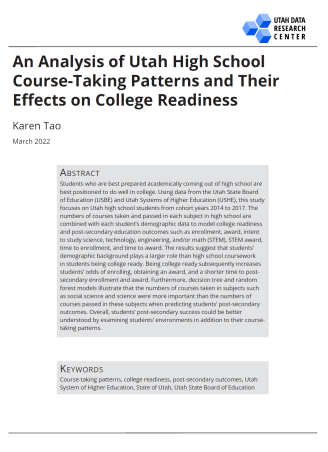Overview
This study investigates the effects of students' taking specific high school courses on their college readiness and post-secondary education outcomes. Using data from the Utah State Board of Education (USBE) and Utah System of Higher Education (USHE), this study focuses on Utah high school students from cohorts 2014 to 2017. The number of courses taken and passed in each subject in high school is combined with each student's demographic data to model college readiness and post-secondary education outcomes.
Understanding the effects of high school course-taking patterns may be valuable for the students, school administrators, and policymakers. For students, awareness of how a course contributes to their future educational and career outcomes may motivate their efforts in various classes. For school administrators, knowing the benefits of classes in each subject area may assist in creating a curriculum that adequately prepares their students. Finally, for policymakers, a deep understanding of the effects of courses from each subject area could be crucial in designing and interpreting metrics that evaluate school and students' education outcomes.
No single factor can fully account for the complex interactions of students' course selection and their academic achievements. This study does not address the self-selection into certain courses in high school, and causal relationships between course selection and post-secondary outcomes are not established.
Summary of Findings:
- Courses that increase students' odds of being college ready include social studies courses passed, foreign language courses taken, language arts courses passed, and mathematics courses passed.
- English learners, multiracial students, low-income families, and special education students faced decreased odds of being college ready.
Finding 2: Post-Secondary enrollment
- Students were over five times more likely to enroll at a post-secondary institution for each increment in college readiness.
- Students' demographic background plays a prominent role in students' enrolling in post-secondary education.
Finding 3: Post-Secondary awards
- Students were 58% more likely to receive at least one award at a post-secondary institution for each increment in college readiness.
- None of the courses in different subject areas affected the odds of obtaining a post-secondary award by more than 5%.
Finding 4: Studying STEM in post-secondary education
- For each additional science course taken, a student was 13% more likely to declare intent to study STEM and 17% more likely to receive an award in a STEM-related field.
- Though female students had increased odds of enrolling and receiving an award from post-secondary education, they faced decreased odds of declaring an intent to study STEM and receiving a STEM award.
Finding 5: Time to post-secondary enrollment
- For degree-granting institutions, the time to enroll is shorter for female students, college ready students, Asian students, refugee students, and Hispanic students.
- For technical colleges, the time to enroll is shorter for female students, special education students, and students from low-income families.
Finding 6: Time to post-secondary award
- For degree-granting institutions, the time to award is shorter for multiracial students, female students, low-income students, and college ready students.
- For technical colleges, the time to award is shorter for female students and special education students.


